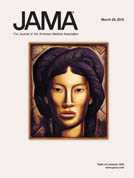JAMA:口服氟喹诺酮类或增加视网膜脱落风险
2012-04-10 练晶军 爱唯医学网
4月4日,国际著名医学杂志《美国医学会杂志》JAMA在线发表的一项研究显示,口服氟喹诺酮类药物似乎会增加视网膜脱落的风险。 氟喹诺酮类药物已被证实与多种眼毒性有关,包括角膜穿孔、视神经病和视网膜出血。不列颠哥伦比亚儿童与家庭研究所的Mahyar Etminan博士指出:“由于这类药物还被警告可能引起肌腱断裂,因此人们更加担心其对眼结缔组织的影响。” Etminan博士及其同事开展了一项病例对照
4月4日,国际著名医学杂志《美国医学会杂志》JAMA在线发表的一项研究显示,口服氟喹诺酮类药物似乎会增加视网膜脱落的风险。
氟喹诺酮类药物已被证实与多种眼毒性有关,包括角膜穿孔、视神经病和视网膜出血。不列颠哥伦比亚儿童与家庭研究所的Mahyar Etminan博士指出:“由于这类药物还被警告可能引起肌腱断裂,因此人们更加担心其对眼结缔组织的影响。”
Etminan博士及其同事开展了一项病例对照研究,评价了药物与视网膜脱落之间的潜在关联。该研究的数据来源于一个医疗数据库,后者覆盖了不列颠哥伦比亚地区的近450万居民。研究者首先确定了2000~2007年间曾前往眼科就诊的989,591例患者,继而进一步选取了其中4,384例视网膜脱落患者。每个病例均与10名年龄匹配而无视网膜脱落的受试者配对。然后在所有受试者中检索此前1年内因任何感染(除外眼科感染)而服用环丙沙星、加替沙星、格帕沙星、左氧氟沙星、莫西沙星、诺氟沙星、氧氟沙星或曲伐沙星的医疗记录。由于眼科感染本身即可增加视网膜脱落风险,因此将这类患者排除。
结果显示,服用氟喹诺酮类药物治疗感染的患者,发生视网膜脱落的几率比未服用者增加近4倍。目前正在服用氟喹诺酮类药物的患者,发生视网膜脱落的风险最高,相对于未服用者的比值比(RR)为4.5。从开具氟喹诺酮类药物处方到发生视网膜脱落的平均间隔时间为4.8 d。在此前2周内或1年内曾服用氟喹诺酮类药物的患者,对风险的增加程度远不如目前服用这样明显,提示这类药物的眼不良作用是急性的。
不过研究者发现,氟喹诺酮类药物服用者发生视网膜脱落的绝对风险仍然很低,仅为4例/1万人-年,换言之,每2,500例服用者中才会发生1例视网膜脱落。“鉴于一般人群中约有10%的人服用氟喹诺酮类药物,估计人群归因风险约为4%”。估计美国每年发生的视网膜脱落中,约有1,440例与服用氟喹诺酮类药物有关。
本研究中,服用氟喹诺酮类药物的最常见指征为呼吸系统感染和生殖系统感染。因胃肠道、皮肤、关节、骨骼或其他系统感染而服药者也较常见。在445例发生视网膜脱落的氟喹诺酮类药物服用者中,环丙沙星所占比例最高(82.7%),其次为左氧氟沙星(7.2%)、诺氟沙星(4.9%)、莫西沙星(4.0%)和加替沙星(1.1%)。
“作为质量控制,我们还检测了一般认为与视网膜脱落无关的另外2类药物——口服β内酰胺类抗生素(青霉素类和头孢类)与速效β受体激动剂——对本研究受试者视网膜脱落风险的影响。结果显示这2类药物均不增加视网膜脱落风险。”
氟喹诺酮类药物的眼不良效应的确切机制尚不清楚,但可能与这类药物对胶原和结缔组织的影响有关。(生物谷Bioon.com)

doi:10.1001/jama.2012.383
PMC:
PMID:
Oral Fluoroquinolones and the Risk of Retinal Detachment
Mahyar Etminan, PharmD, MSc (epi); Farzin Forooghian, MD, MSc, FRCSC; James M. Brophy, MD, PhD, FRCPC; Steven T. Bird, PharmD; David Maberley, MD, MSc, FRCSC
Context Fluoroquinolones are commonly prescribed classes of antibiotics. Despite numerous case reports of ocular toxicity, a pharmacoepidemiological study of their ocular safety, particularly retinal detachment, has not been performed.
Objective To examine the association between use of oral fluoroquinolones and the risk of developing a retinal detachment.
Design, Setting, and Patients Nested case-control study of a cohort of patients in British Columbia, Canada, who had visited an ophthalmologist between January 2000 and December 2007. Retinal detachment cases were defined as a procedure code for retinal repair surgery within 14 days of a physician service code. Ten controls were selected for each case using risk-set sampling, matching on age and the month and year of cohort entry.
Main Outcome Measure The association between retinal detachment and current, recent, or past use of an oral fluoroquinolone.
Results From a cohort of 989 591 patients, 4384 cases of retinal detachment and 43 840 controls were identified. Current use of fluoroquinolones was associated with a higher risk of developing a retinal detachment (3.3% of cases vs 0.6% of controls; adjusted rate ratio [ARR], 4.50 [95% CI, 3.56-5.70]). Neither recent use (0.3% of cases vs 0.2% of controls; ARR, 0.92 [95% CI, 0.45-1.87]) nor past use (6.6% of cases vs 6.1% of controls; ARR, 1.03 [95% CI, 0.89-1.19]) was associated with a retinal detachment. The absolute increase in the risk of a retinal detachment was 4 per 10 000 person-years (number needed to harm = 2500 computed for any use of fluoroquinolones). There was no evidence of an association between development of a retinal detachment and β-lactam antibiotics (ARR, 0.74 [95% CI, 0.35-1.57]) or short-acting β-agonists (ARR, 0.95 [95% CI, 0.68-1.33]).
Conclusion Patients taking oral fluoroquinolones were at a higher risk of developing a retinal detachment compared with nonusers, although the absolute risk for this condition was small.
本网站所有内容来源注明为“梅斯医学”或“MedSci原创”的文字、图片和音视频资料,版权均属于梅斯医学所有。非经授权,任何媒体、网站或个人不得转载,授权转载时须注明来源为“梅斯医学”。其它来源的文章系转载文章,或“梅斯号”自媒体发布的文章,仅系出于传递更多信息之目的,本站仅负责审核内容合规,其内容不代表本站立场,本站不负责内容的准确性和版权。如果存在侵权、或不希望被转载的媒体或个人可与我们联系,我们将立即进行删除处理。
在此留言














#喹诺酮#
51
#视网膜#
48
#氟喹诺酮#
0